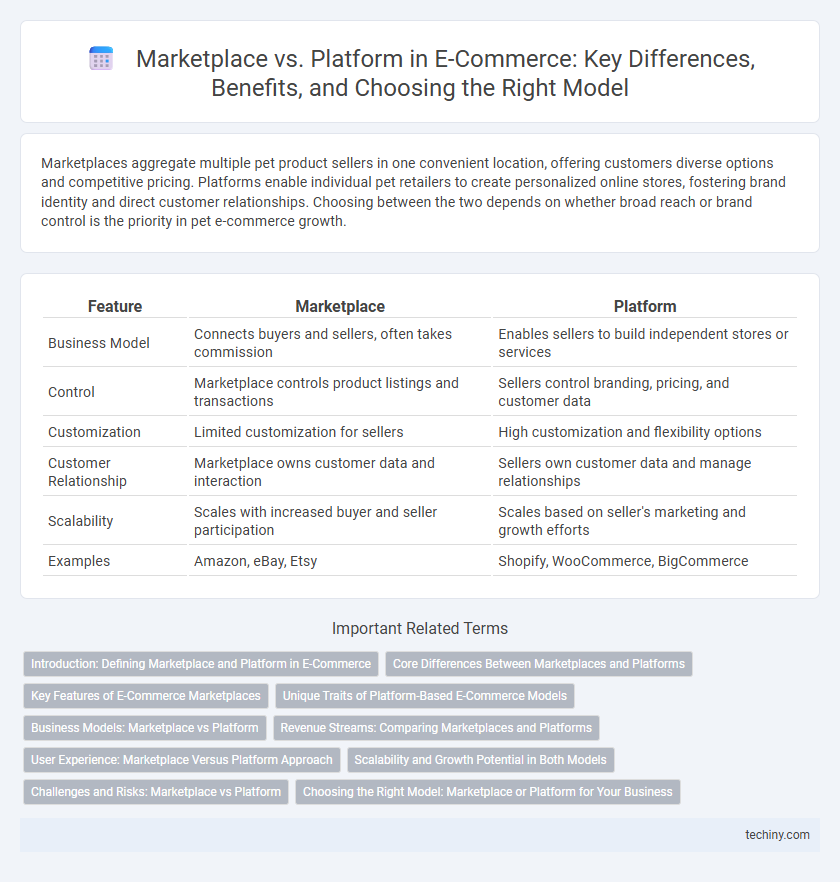Marketplaces aggregate multiple pet product sellers in one convenient location, offering customers diverse options and competitive pricing. Platforms enable individual pet retailers to create personalized online stores, fostering brand identity and direct customer relationships. Choosing between the two depends on whether broad reach or brand control is the priority in pet e-commerce growth.
Table of Comparison
| Feature | Marketplace | Platform |
|---|---|---|
| Business Model | Connects buyers and sellers, often takes commission | Enables sellers to build independent stores or services |
| Control | Marketplace controls product listings and transactions | Sellers control branding, pricing, and customer data |
| Customization | Limited customization for sellers | High customization and flexibility options |
| Customer Relationship | Marketplace owns customer data and interaction | Sellers own customer data and manage relationships |
| Scalability | Scales with increased buyer and seller participation | Scales based on seller's marketing and growth efforts |
| Examples | Amazon, eBay, Etsy | Shopify, WooCommerce, BigCommerce |
Introduction: Defining Marketplace and Platform in E-Commerce
A marketplace in e-commerce serves as a centralized digital venue where multiple third-party sellers list and sell products directly to consumers, facilitating transactions without owning inventory. In contrast, a platform provides the underlying technology infrastructure enabling businesses to build, operate, and scale their own online stores or services, often including payment processing, logistics, and customer engagement tools. Understanding the distinction between marketplace and platform helps businesses choose the optimal model for reaching customers, controlling branding, and managing operations effectively.
Core Differences Between Marketplaces and Platforms
Marketplaces act as intermediaries that facilitate transactions between buyers and sellers, often handling payments, product listings, and dispute resolutions. Platforms provide the foundational technology and infrastructure that enable third parties to build applications or services, offering greater customization and control but requiring more development effort. The core difference lies in marketplaces being transactional ecosystems centered on exchange, while platforms serve as versatile environments for innovation and integration.
Key Features of E-Commerce Marketplaces
E-commerce marketplaces aggregate multiple third-party sellers, offering a broad product selection and streamlined comparison for buyers within a single platform. Key features include integrated payment processing, robust search and filtering capabilities, customer reviews, and secure transaction management. These marketplaces handle inventory management and customer service, facilitating seamless interactions between buyers and sellers while ensuring trust and convenience.
Unique Traits of Platform-Based E-Commerce Models
Platform-based e-commerce models uniquely facilitate interactions between multiple user groups, such as buyers, sellers, and service providers, within a single ecosystem. These platforms leverage network effects, where increased participation enhances overall value, driving scalability and diverse offerings. Unlike marketplaces, platforms often provide tools for customization, integration, and seamless third-party contributions, enabling personalized user experiences and fostering innovation.
Business Models: Marketplace vs Platform
Marketplace business models connect buyers and sellers through a centralized platform, earning revenue via transaction fees or commissions on sales. Platform models provide the underlying technology infrastructure enabling multiple types of interactions, emphasizing scalability and extensibility for third-party integrations. Marketplaces prioritize direct commerce facilitation, while platforms focus on enabling diverse ecosystems, often monetizing through subscriptions, licensing, or value-added services.
Revenue Streams: Comparing Marketplaces and Platforms
Marketplaces generate revenue primarily through transaction fees, commissions, and listing charges, leveraging high-volume sales and vendor participation to maximize income. Platforms earn revenue from diverse streams such as subscription fees, premium services, advertising, and data monetization, enabling scalable growth through user engagement and value-added features. This difference influences business models, with marketplaces emphasizing sales volume and platforms focusing on user retention and ecosystem expansion.
User Experience: Marketplace Versus Platform Approach
Marketplaces centralize multiple sellers, providing users with a diverse product selection and unified checkout process, enhancing convenience and comparison shopping. Platforms emphasize direct interactions between buyers and sellers, often offering personalized experiences and customizable interfaces tailored to user preferences. Optimizing user experience depends on balancing broad variety with seamless navigation, trust signals, and integrated support features essential in e-commerce environments.
Scalability and Growth Potential in Both Models
Marketplaces offer rapid scalability by aggregating multiple sellers and buyers on a single platform, leveraging network effects to drive exponential growth and increased transaction volume. Platforms provide greater control over user experience and data, enabling tailored services and long-term customer loyalty but may require substantial initial investment and time to scale. Both models exhibit distinct growth dynamics, with marketplaces capitalizing on rapid market penetration and platforms focusing on sustainable expansion through ecosystem development.
Challenges and Risks: Marketplace vs Platform
Marketplaces face challenges such as intense competition and dependency on third-party sellers, leading to quality control and trust issues. Platforms must address risks related to user data security, platform governance, and maintaining seamless integration among diverse services. Both models require robust strategies to mitigate seller fraud, manage scalability, and comply with regulatory requirements in dynamic e-commerce landscapes.
Choosing the Right Model: Marketplace or Platform for Your Business
Choosing the right model between a marketplace and a platform depends on your business goals, target audience, and revenue structure. Marketplaces facilitate direct transactions among multiple sellers and buyers, earning through commissions or listing fees, while platforms offer tools and infrastructure for third-party services, emphasizing scalability and customization. Analyzing factors such as control over user experience, integration capabilities, and monetization strategies helps determine the optimal model for sustainable growth in e-commerce.
Marketplace vs Platform Infographic

 techiny.com
techiny.com